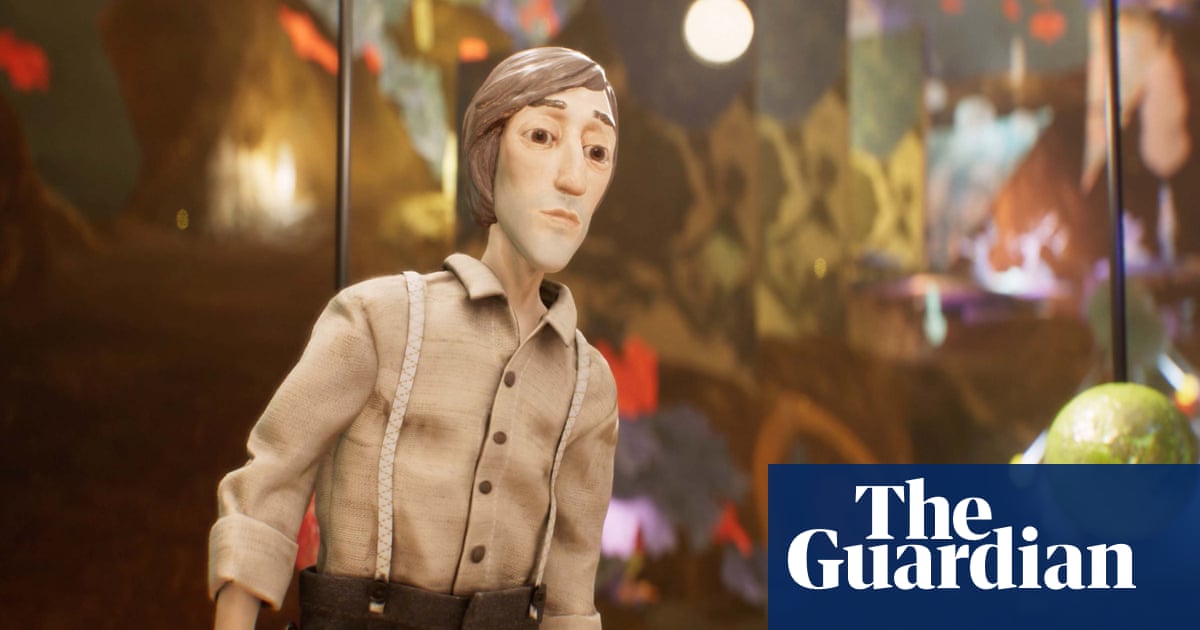Ticktock, ticktock. In the dripping confines of the Fedora 1, an aquatic space colony of exquisite retro-futuristic design, it’s not water but time that exerts an unmistakable pressure on inhabitants. A cataclysmic meteor looms on the horizon, threatening to wipe them all out. But this cast of lovably eccentric characters, including the titular Harold, hurry for no one, preferring to amble about their days while staring down the barrel of cosmic disaster.
It’s fitting that an adventure game as laid back in pacing as Harold Halibut should have been made by a team with a similarly leisurely approach to time. Fourteen years have passed since game director Onat Hekimoglu had the initial idea, while studying for an MA at Cologne Game Lab. Back then, it was a strange point-and-click adventure with earthy stop-motion visuals. Elements of that version persist today, namely protagonist Harold, a depressed caretaker who spends his days gazing out at the sea. But the intervening years have seen it become more mechanically refined, narratively expansive and visually beautiful.
Now Harold Halibut is a spectacular synthesis of analogue and virtual that is so tactile – so texturally convincing – that, at various points playing the game, you may want to reach into the screen and physically touch it.
Hekimoglu, who studied film before video games, notes this uncanny quality – that Harold Halibut is a game with “stylised” visuals that, paradoxically, looks “photorealistic”. Nailing down the aesthetic took two years of intensive experimentation. Initially, it was a true stop-motion game made with puppets, in which every frame was laboriously captured on camera. But, says Hekimoglu, the “2D sprites of stop motion characters sitting on top of beautifully lit photographic backgrounds didn’t feel right – it didn’t feel unified.” So the tiny team of four, from two studios in Cologne, transitioned to a technique known as photogrammetry, scanning their real-world models into a computer and animating within the game software.
The resulting game, where you direct a figurine around an intricate virtual play set, feels as if it was made by Wes Anderson running amok at Aardman Animations. Art director Ole Tillmann, who studied illustration at Rhode Island School of Design before working for Disney, took a lot of pleasure in creating the puppets, re-establishing “broken childhood connections” in the process. Simply having the puppets in the room while devising the story caused the imaginations of Tillmann, Hekimoglu and studio co-founders Fabian Preuschoff and Daniel Beckmann to flare off in unforeseen directions.
Like sci-fi movie classics such as Solaris, the game’s drama unfolds at macro-cosmic and micro-cosmic scales, contemplating the universe’s biggest questions while delving into the interior lives of its quirky cast. In one sequence, we see Harold croon at the top of his lungs while cleaning a giant filtration pump, transforming, in that moment, from a man who does a dull job without complaining to a person with long-repressed feelings. This sweet, tender scene sets up the rest of the game: Harold’s search for the meaning of life in a surprisingly cosy corner of the universe.
As development progressed, the team transitioning from one pot of funding to another, all while working ad-hoc contract jobs, the technology behind Harold Halibut gradually improved. During the experimental photogrammetry phase of the project, “it was obvious that there were limitations with Unity [the software used to make the game],” says Hekimoglu. Lighting was off; the engine couldn’t accommodate their gigantic HD scans. But physically based rendering arrived in 2015 which helped in-game objects seem more real. With further major software updates, the team were able to sometimes jump, rather than simply edge, closer to their ultimate vision. At these points, jokes Hekimoglu, it was as if they had “already made a remaster of the game”.
Tillmann reflects that Harold Halibut’s unconventional development happened in reverse to most games. “People usually start with the technical limitations and then adapt their creative decision-making to that,” he says. “We came up with the world-building, how things look, the concept art – mood, lighting, and atmosphere – very early on. And then it took all that time for the [technology] to get closer to that.” He says the team has now reached a satisfying conclusion – “having it look the way we envisioned it all that time ago”.
after newsletter promotion
Even though it’s been 14 years since Hekimoglu’s first concept, it would be inaccurate to say that Harold Halibut ever languished in development hell. Rather, this group of artists – outsiders to the video game industry – kept on working steadily according to an entirely different commercial logic, to an entirely different schedule. There were low points, certainly: the mutual termination of a contract with publisher Curve Games, the Covid-19 pandemic, a crisis in a team that he says had reached “breaking point”.
But these events galvanised the group, says Tillmann. It was during such months that the team vowed to one another, with a similar resolve to that of their unlikely hero, Harold: “Whatever happens, we’ll push through to the end.”







